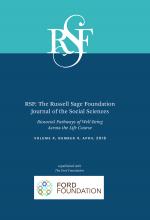Research Article
Open Access
The Sociogenomics of Polygenic Scores of Reproductive Behavior and Their Relationship to Other Fertility Traits
Melinda C. Mills, Nicola Barban, Felix C. Tropf
RSF: The Russell Sage Foundation Journal of the Social Sciences April 2018, 4 (4) 122-136; DOI: https://doi.org/10.7758/RSF.2018.4.4.07
Melinda C. Mills
aNuffield Professor of Sociology at the University of Oxford and Nuffield College and leads the Sociogenome project, University of Oxford, OX1 3UQ United Kingdom
Nicola Barban
bSenior research associate in the Department of Sociology at the University of Oxford and Nuffield College
Felix C. Tropf
cPostdoctoral researcher in the Department of Sociology at the University of Oxford and Nuffield College

REFERENCES
- ↵
- Ajzen, Icek.
- ↵
- ↵
- ↵
- ↵
- ↵
- ↵
- Boivin, Jacky,
- Laura Bunting,
- John A. Collins, and
- Karl G. Nygren.
- ↵
- Brewster, Karin L., and
- Ronald R. Rindfuss.
- ↵
- Briley, Daniel A.,
- Felix C. Tropf, and
- Melinda C. Mills.
- ↵
- ↵
- Courtiol, Alexandre,
- Felix C. Tropf, and
- Melinda C. Mills.
- ↵
- Cox, David R.
- ↵
- Euesden, Jack,
- Cathryn M. Lewis, and
- Paul F. O’Reilly.
- ↵
- Felson, Jacob.
- ↵Fisher, Ronald A. 1930. The Genetical Theory of Natural Selection. Oxford: Oxford University Press.
- ↵
- ↵
- Juster, F. Thomas, and
- Richard Suzman.
- ↵
- ↵
- ↵
- Kohler, Hans-Peter,
- Joseph L. Rodgers, and
- Kaare Christensen.
- ↵
- ↵
- Lichtenstein, Paul,
- Patrick F. Sullivan,
- Sven Cnattingius,
- Margaret Gatz, et al, .
- ↵
- Manolio, Teri A.,
- Francis S. Collins,
- Nancy J. Cox,
- David B. Goldstein, et al, .
- ↵
- McDonald, Peter.
- ↵Mills, Melinda C. 2011. Introducing Survival and Event History Analysis. Menlo Park, Calif.: Sage Publications.
- ↵Mills, Melinda C., Hans-Peter Blossfeld, and Erik Klijzing. 2005. “Becoming an Adult in Uncertain Times.” In Globalization, Uncertainty and Youth in Society, edited by H. P. Blossfeld, Erik Klijzing, Melinda Mills, and Karin Kurz. London: Routledge.
- ↵
- Mills, Melinda C.,
- Ronald R. Rindfuss,
- Peter McDonald, and
- Egbert te Velde.
- ↵
- Mills, Melinda C., and
- Felix C. Tropf.
- ↵
- Moayyeri, Alireza,
- Christopher J. Hammond,
- Anna M. Valdes, and
- Timothy D. Spector.
- ↵
- Mostafavi, Hakhamanesh,
- Tomaz Berisa,
- Felix Day,
- John Perry,
- Molly Przeworski, and
- Joseph K. Pickrell.
- ↵
- ↵
- ↵
- ↵
- ↵
- Purcell, Shaun,
- Benjamin M. Neale,
- Kathe Todd-Brown,
- Lori Thomas,
- Manuel A. R. Ferreira,
- David Bender,
- Julian Maller,
- Paul I. W. de Bakker,
- Mark Daly, and
- Pak C. Sham.
- ↵
- Rietveld, Cornelius A.,
- Sarah E. Medland,
- Jaime Derringer,
- Jian Yang, et al, .
- ↵
- Rindfuss, Ronald R.,
- S. Philip Morgan, and
- Kate Offutt.
- ↵
- Rodgers, Joseph Lee,
- Kimberly Hughes,
- Hans-Peter Kohler,
- Kaare Christensen,
- Debby Doughty,
- David C. Rowe, and
- Warren B. Miller.
- ↵
- ↵
- Tropf, Felix C., and
- Jornt J. Mandemakers.
- ↵
- Tropf, Felix C.,
- Renske M. Verweija,
- Peter J. van der Most,
- Gert Stulp, et al, .
- ↵
- Verweij, Renske M.,
- Melinda C. Mills,
- Felix C. Tropf,
- René Veenstra,
- Anastasia Nyman, and
- Harold Snieder.
- ↵
- ↵
- Yang, Jian,
- Beben Benyamin,
- Brian P. McEvoy,
- Scott Gordon, et al, .
- ↵
- ↵
- ↵
- Zietsch, Brendan P.,
- Ralf Kuja-Halkola,
- Hasse Walum, and
- Karin J. Verweij.
- ↵
- Zuk, Or,
- Eliana Hechter,
- Shamil R. Sunyaev, and
- Eric S. Lander.
In this issue
The Sociogenomics of Polygenic Scores of Reproductive Behavior and Their Relationship to Other Fertility Traits
Melinda C. Mills, Nicola Barban, Felix C. Tropf
RSF: The Russell Sage Foundation Journal of the Social Sciences Apr 2018, 4 (4) 122-136; DOI: 10.7758/RSF.2018.4.4.07
Jump to section
Related Articles
- No related articles found.





